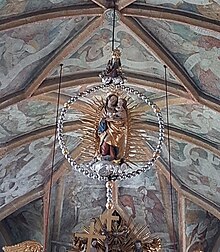Assumption of Mary (Weildorf)
The Roman Catholic Church of the Assumption of Mary is a late Gothic hall church in the Weildorf district of Teisendorf in the Berchtesgadener Land district in Upper Bavaria . It belongs to the parish of the Assumption of Mary Weildorf in the dean's office Berchtesgadener Land of the Archdiocese of Munich and Freising .
History and architecture
Weildorf was originally cared for by the Archabbey of St. Peter in Salzburg , and the Weildorf branch has belonged to the Teisendorf parish since the 2nd quarter of the 14th century. A pilgrimage must have already been made before the current building, as the complex, uniform new building would not be conceivable without it. In 1786 a vicariate was established to provide better pastoral care to the pilgrims, which was elevated to a parish in 1876.
The church is a hall church, consecrated in 1429, with a single-bay choir with a five-eighth end . The tower (1427/1429), which is Gothic up to the height of the cornice, is completed with an upper floor and a hood from 1766/1767. To the south there is an annex from the 17th century, which, in addition to the sacristy, also contains the vestibule and a chapel. A multi-tiered Gothic portal from 1427/1429 with an iron-studded door from the 16th century opens up the building.
The interior is closed off by a reticulated vault that rests on octagonal posts with profiled fighters . The slender choir arch slightly accentuates the separation from the ship. A gallery is built into the west yoke over ribbed arcades.
Furnishing
A special feature are the largely preserved vault paintings from around 1510. A Christmas cycle, prophets, saints with banners and the death of the Virgin on the south wall of the choir are shown; plant motifs can be found in the nave. The tracery of the windows and galleries, like the side altars, was evidently renewed in a neo-Gothic style. According to an inscription in the pulpit, the executing artists of this renewal were “ Matthäus Kern sculps., Alex (other) Huber pinx . 1858 ".
The high altar was created in 1732/33 by the Salzburg carpenter Thaddäus Baldauf and equipped with carved figures of Immaculata and Saints Barbara and Katharina , which were made by Georg Joseph Frieß. A rosary Madonna from around 1500 with a later added halo and clouds (18th century) is attached to the choir arch . The crowning half-figure of God the Father may have come from the demolition of the former late Gothic high altar.
The artistic choir grille was created by master locksmith Dominikus Lindner from Teisendorf. In the shrine on the left Anna altar there is a late Gothic sculpture of Anna the third (after 1500). Like the pulpit and the shrine of the Anna altar, the right Joseph altar is a work by Matthäus Kern. The crucifix on the southern nave wall from 1648 was made by the Salzburg Wolf Weißenkirchner .
The organ is a work by Ferdinand Hörmüller from Tittmoning from 1842, which was rebuilt in 1939 by Julius Zwirner from Munich while simplifying the prospectus.
The fixtures in the sacristy date from the 17th century. In the chapel there is an early baroque marble altar with the Weildorf Madonna in the type of the beautiful Madonnas from around 1430, which was created by the master von Seeon . It was originally located in the middle shrine of a Gothic winged altar and was installed behind the newly created Renaissance altar in 1596 and finally transferred to the newly built portal chapel in 1645. The current altar dates from the late 17th century and is decorated with figures of Saints Wolfgang and Sebastian that do not belong to it. The Madonna is considered to be the most valuable work of art in the region and the second most important work of the master after the Madonna of the high altar in Seeon Abbey .
Numerous votive candles and votive pictures are kept in the Marienkapelle , including a fold-out plaque of vows of the war participants from 1871, which was created by Josef Hitzinger from Teisendorf. On the last Sunday in July, the chapel is the destination of a pilgrimage for the reservists and veterans of the Warrior Oath Association Weildorf and the surrounding area , in which up to 15 associations and delegations with around 1500 pilgrims take part.
literature
- Handbook of German Art Monuments . Bayern IV: Munich and Upper Bavaria. Deutscher Kunstverlag, Munich, Berlin 2006, ISBN 978-3-422-03115-9 , p. 1367.
- Hans Roth: Assumption of Mary Weildorf (= Little Art Guide No. 1829). Schnell & Steiner, Regensburg 1990.
Web links
Individual evidence
- ↑ Information about Church Weildorf on the website of Berchtesgadener Land und Tourismus GmbH. Retrieved August 6, 2019 .
Coordinates: 47 ° 51 ′ 43.3 " N , 12 ° 52 ′ 16.2" E




